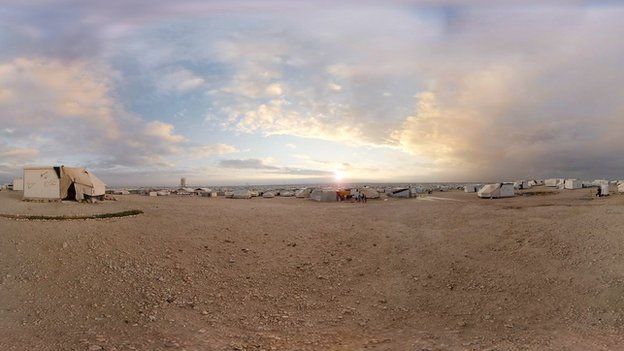Virtual reality looks for a role in journalism
- Published

I recently visited a refugee camp for Syrians, spending time in the home of 12-year-old Sidra, accompanying her to a makeshift school, meeting her friends and watching children playing football on a rubble pitch or pass the time in a woefully ill-equipped gym.
It brought home to me the reality of life for the millions of displaced Syrians, trying to make the best of daily life in the face of an uncertain future.
But I did not go to Jordan, where the Zaatari camp is based, to experience all this. Instead I made my visit via a virtual reality (VR) headset at the Ted (Technology, Entertainment and Design) conference in Vancouver.
Film-maker Chris Milk spoke at the event in the Canadian city about how he wanted to use technology as an empathy tool - and delegates got a chance to watch for themselves the film that his team had made.
An estimated four million Syrians have become refugees since the conflict began, according to the United Nations High Commissioner for Refugees (UNHCR), of whom a million are children.
'Changing lives'
Clouds Over Sidra, which shows life for refugees from one child's perspective, was made in partnership with the UN and Samsung, which supplied the Gear VR headset.
It was made using a 360-degree camera with scenes then stitched together.
It was shown at the World Economic Forum in Davos in January, where a series of state and business leaders were given the chance to watch it.
For Mr Milk, being able to show the film at Davos was important.
"We took it there to show to people who can change the lives of the people in the film," he said during his Ted talk.
Film-makers are increasingly seeing the benefit of using virtual reality to give viewers a far more empathetic view of things than has ever been possible before.
'More human'
Film director Rose Troche made a film about sexual assault on college campuses, which invited viewers to experience the reality of rape from the male and female perspectives.
And in 2012 film-maker Nonny de la Pena, seen by many as the godmother of virtual reality films, showed off her "immersive journalism" piece Hunger in Los Angeles, which won plaudits at the Sundance Film Festival. She has since made a follow-up film, also highlighting the civil war in Syria.
She told the BBC: "Virtual reality, as a journalistic medium, will follow a similar trajectory as newspaper, radio and television.
"And like those different platforms, virtual reality has its own affordances, the most exciting being the embodied feeling of being 'on scene'. This can give the audience a deep and more visceral understanding of a story."
For Mr Milk, VR offers a way to "connect humans to other humans in a profound way". Virtual reality, he said, had the power "to change the world.
"It is just a machine but through it you can become more passionate and empathetic and ultimately more human."
Gabo Arora, senior adviser at the UN, who also worked on the project said: "By leveraging breakthrough technologies, such as virtual reality, we can create solidarity with those who are normally excluded and overlooked, amplifying their voices and explaining their situations."
They are bold claims for a technology that many remain sceptical about.
VR has long promised and never quite delivered but, in recent months, it has stepped up a gear with a series of announcements and demonstrations suggesting that the technology is nearing maturity and mass-market adoption.
Sony, Samsung and the Facebook-owned Oculus Rift all have headsets that provide a good consumer experience.
But it still has some technological hurdles to overcome - a lot of people testing the current headsets on the market report that it makes them feel sick or woozy.
My own experience of watching the Syrian film was that it was somewhat blurry - something that was not rectified by adjusting the focus or even by wearing glasses beneath the headset.
The focus of developers making content for VR is currently on gaming, so can it also play a role in film-making and journalism?
"The technology is just at the beginning of being used as a story-telling medium," said Piers Harding-Rolls, head of games research at analyst firm IHS.
Visceral reaction
"When you experience films such as Clouds Over Sidra, it makes quite an impact. It is not a passive experience and there is a small amount of interactivity because you can look around you. Like any piece of journalism this can be quite powerful. It adds a dynamic to the storytelling."
Increasingly, he said, Hollywood studios are looking to the potential of VR as a entertainment medium, and short promotional films are already being shot using the technology.
Using virtual reality as a tool for empathy is an interesting way to elicit a visceral reaction from audiences that are now more than familiar with surround sound, 3D and special effects.
I can testify that watching the film was a very moving experience. You really believe you are walking alongside the children and experience the details of their lives as if you were with them. If you reach out your hand you believe you can touch them.
And when you take the headset off and find yourself in the Vancouver Convention Centre you feel a little disorientated and rather silly particularly if, like me, you have tears streaming down your face.
- Published4 March 2015
- Published4 March 2015